Chimichurri is a quick, delicious, bright sauce you can use as a topping for many dishes. The main ingredients are olive oil, parsley, garlic, vinegar, and red pepper flakes.
Learn how to make the original chimichurri recipe, popular in Argentina and Uruguay. It only takes 5 minutes and 7 simple ingredients.
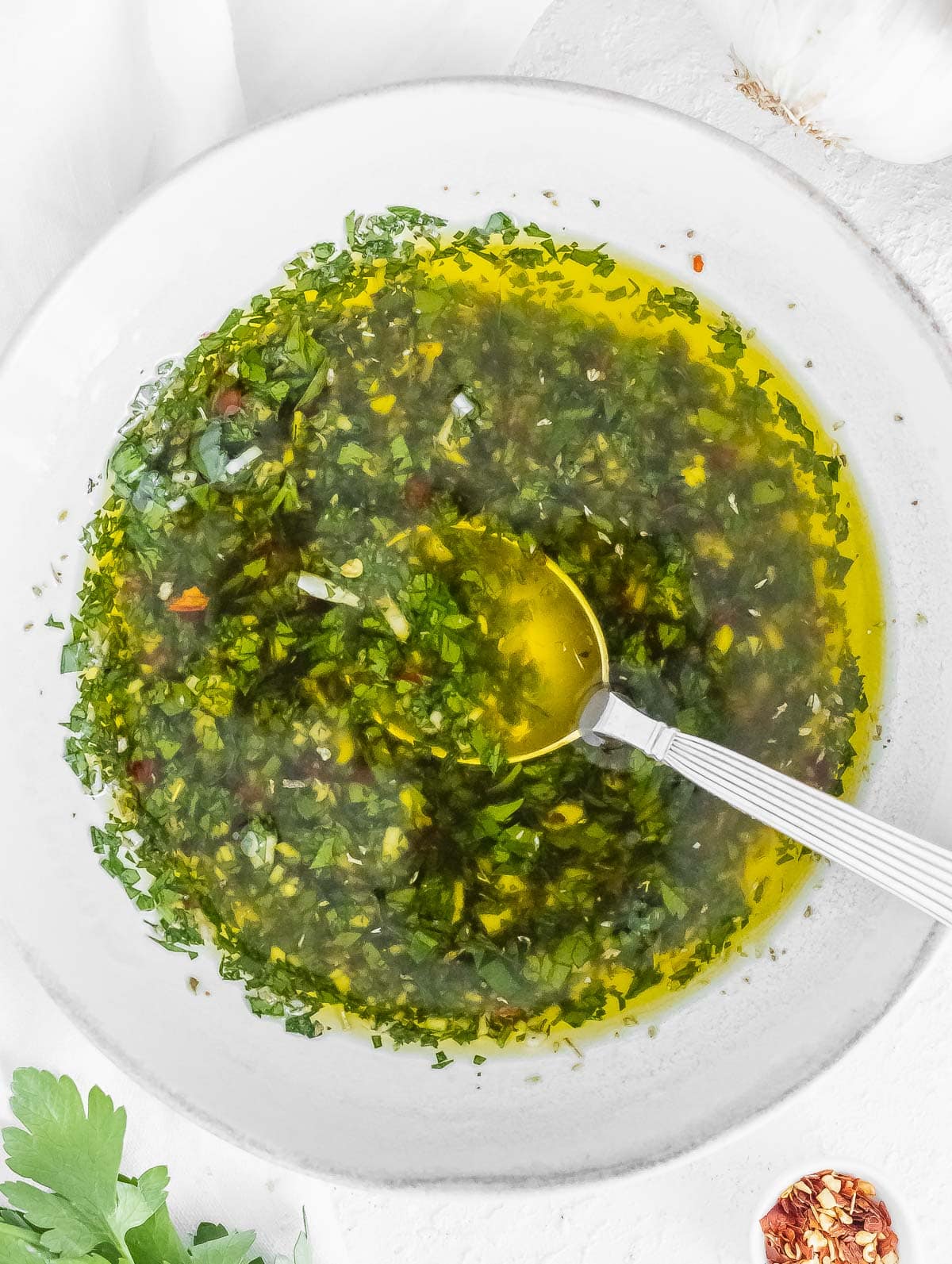
Table of Contents
Check out our best sauce recipes.
What is chimichurri?
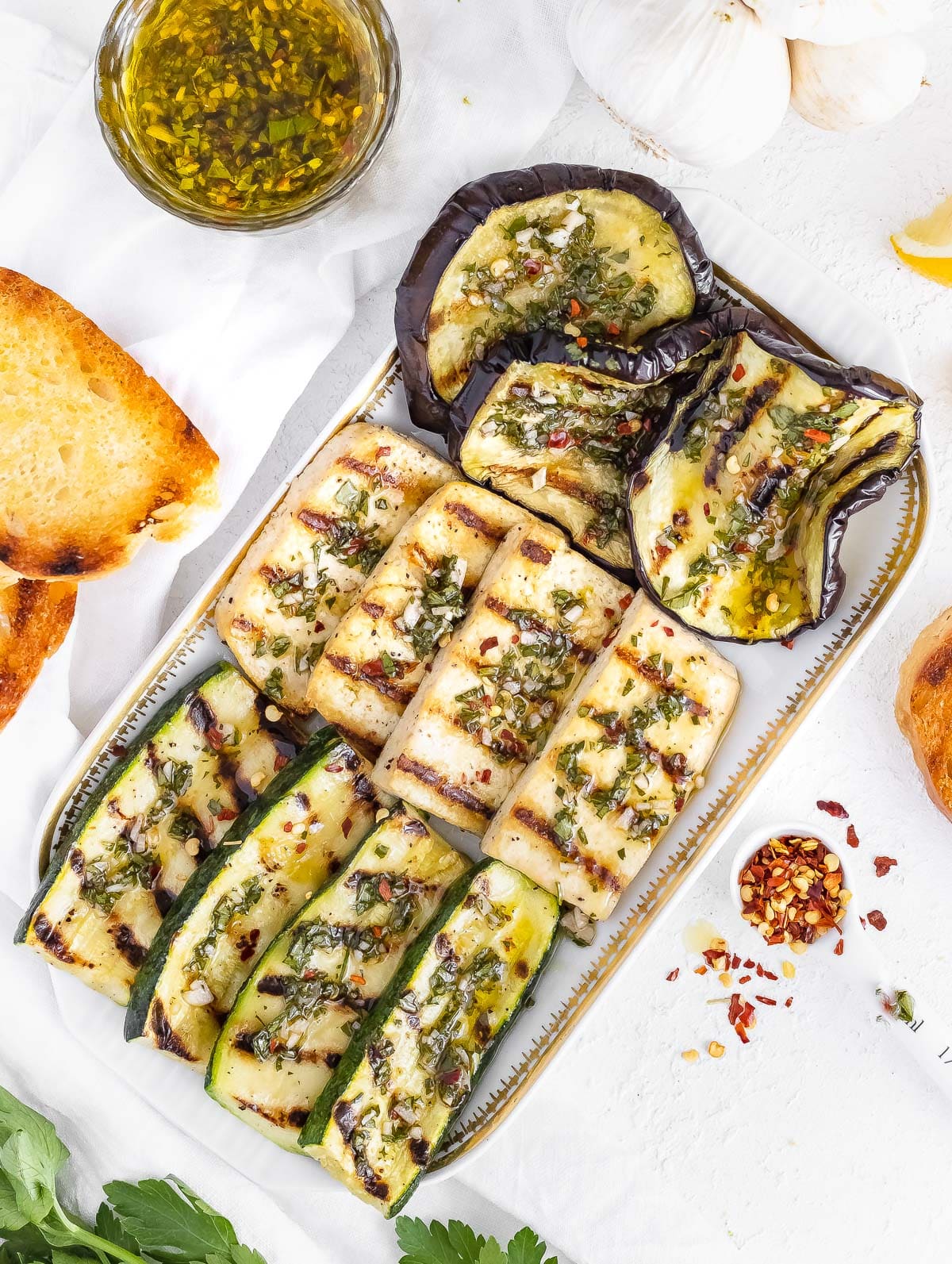
Chimichurri is a condiment popular in Argentina, Paraguay, and Uruguay. Recently chimichurri has been spreading all over the world pretty quickly, especially in the USA.
In South America, chimichurri is as loved as “Asado” or barbeque, a social ritual that brings family and friends together over grilled meat. And where there’s grilling, there’s chimichurri, drizzled or spooned generously over meat, fish, and vegetables.
The combination of ingredients in Chimichurri sauces goes particularly well with the charred, smokey flavor of grilled foods.
What does chimichurri taste like?
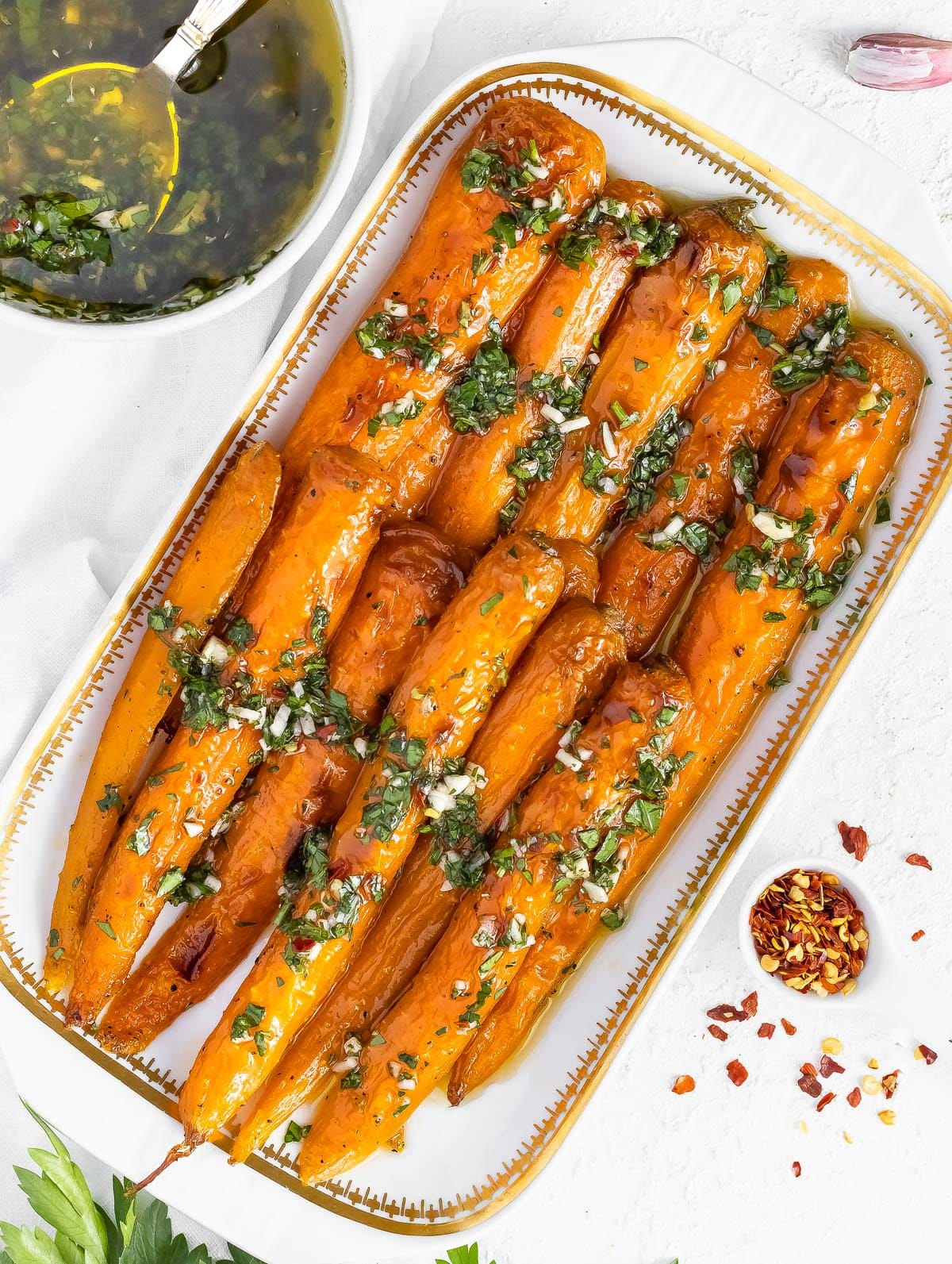
Chimichurri is fresh and bright thanks to the vinegar, herby and aromatic thanks to parsley and oregano, and tangy and spicy thanks to the garlic and chili.
If you follow a plant-based diet as we do, you can still enjoy chimichurri. It’s a fantastic condiment that goes well with more than just grilled meats.
It’s an incredible ally to add flavor to most vegetables and sides, cooked in most ways, from grilled zucchini and eggplant to boiled potatoes, from oven-roasted carrots to air-fried cauliflower.
You can even use it as a dressing to toss with beans, chickpeas, and pasta salad, or even better to drizzle on grilled tofu. Let’s see what’s in it.
Ingredients
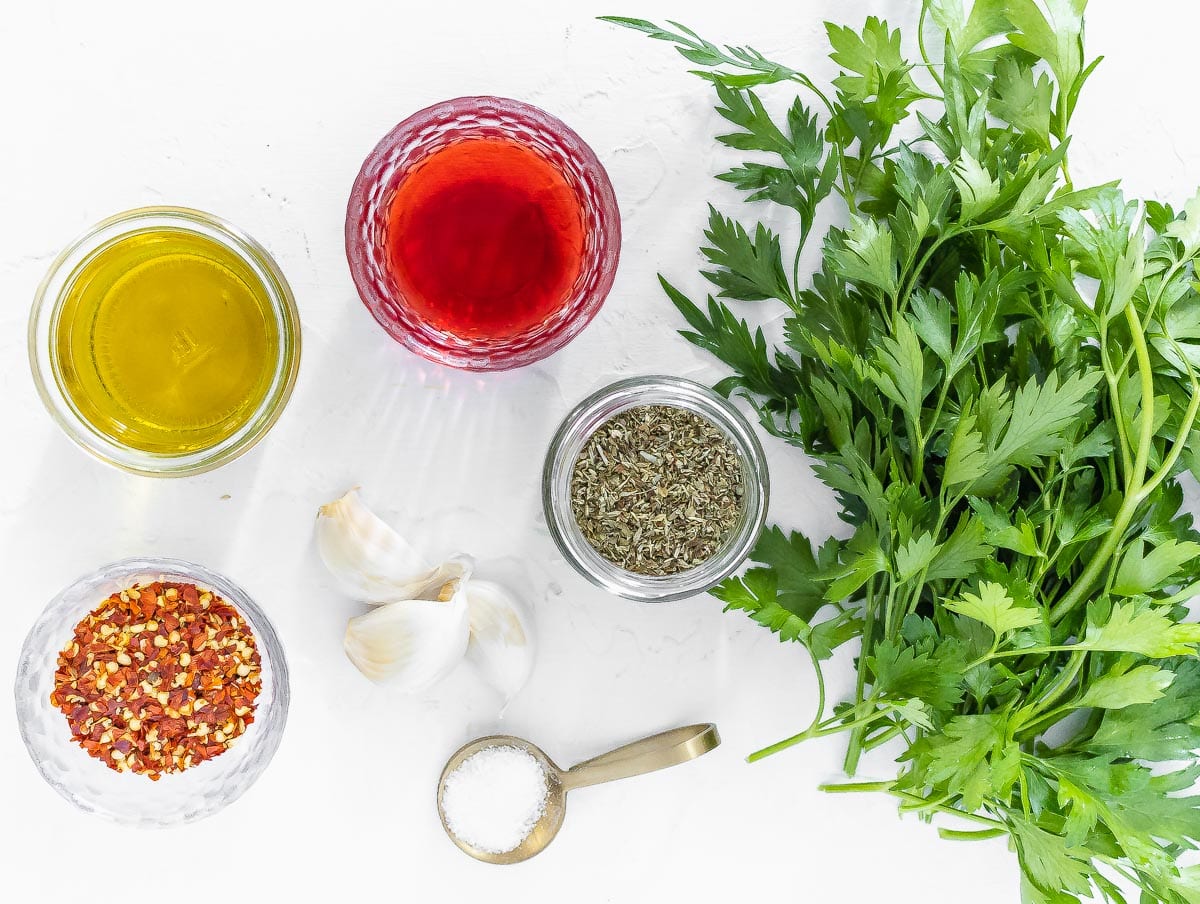
Parsley: you can use either flat-leaf parsley or curly parsley. Flat-leaf parsley has a bolder, more aromatic flavor so we use and recommend that.
Oregano: dry oregano is used in the original recipe. We recommend sticking to that.
Garlic: use fresh garlic, finely minced. You can use more or less garlic based on your preferences. Try to avoid garlic powder.
Oil: we use and recommend extra virgin olive oil because it’s more aromatic and healthier than most other oils. However, in South America, some people also use sunflower seed oil, regular olive oil, or other vegetable oils.
Vinegar: red wine vinegar is the most used. White wine vinegar works too. If you are serving chimichurri with fish you can replace the vinegar with lemon juice.
Red pepper flakes: to add heat obviously. Again, the quantity depends on your taste. You can even leave them out completely if you don’t like your chimichurri spicy.
Salt: to tie all other flavors together.
Other ingredients
Water: (optional) in Argentina water is often added to chimichurri sauce. We prefer to make it without water, but feel free to add a couple of tablespoons if you like.
Herbs: we keep chimichurri simple and authentic. If you like to make modifications, I’ve seen recipes that call for the use of fresh oregano leaves instead of dry ones and substitute other fresh herbs such as fresh cilantro for the parsley.
Other recipes add shallots or red onion. Our advice is to start with the basic original recipe, see if you like it, and take it from there.
Speaking to my Argentinian friend, it was quickly pointed out to me that there is no rigid recipe for chimichurri and that no one really measures anything when making it.
There are ingredients that people use across Argentina (and South America) to make this sauce. But the quantities depend on personal taste.
In this recipe, we stay as close as possible to the original. We do not make any modifications to the ingredients.
Use our quantities as a guideline, changing them slightly based on your tastes. If you like it spicier add more chili. If you like it brighter and more acidic, add more vinegar.
Instructions
Chop the parsley
The first step is to wash and dry the parsley. To dry it, shake off as much water as you can. You can also wrap it in a clean kitchen cloth and pat it dry gently.
Discard the thicker stems of the parsley. You can snap them off with your hands.
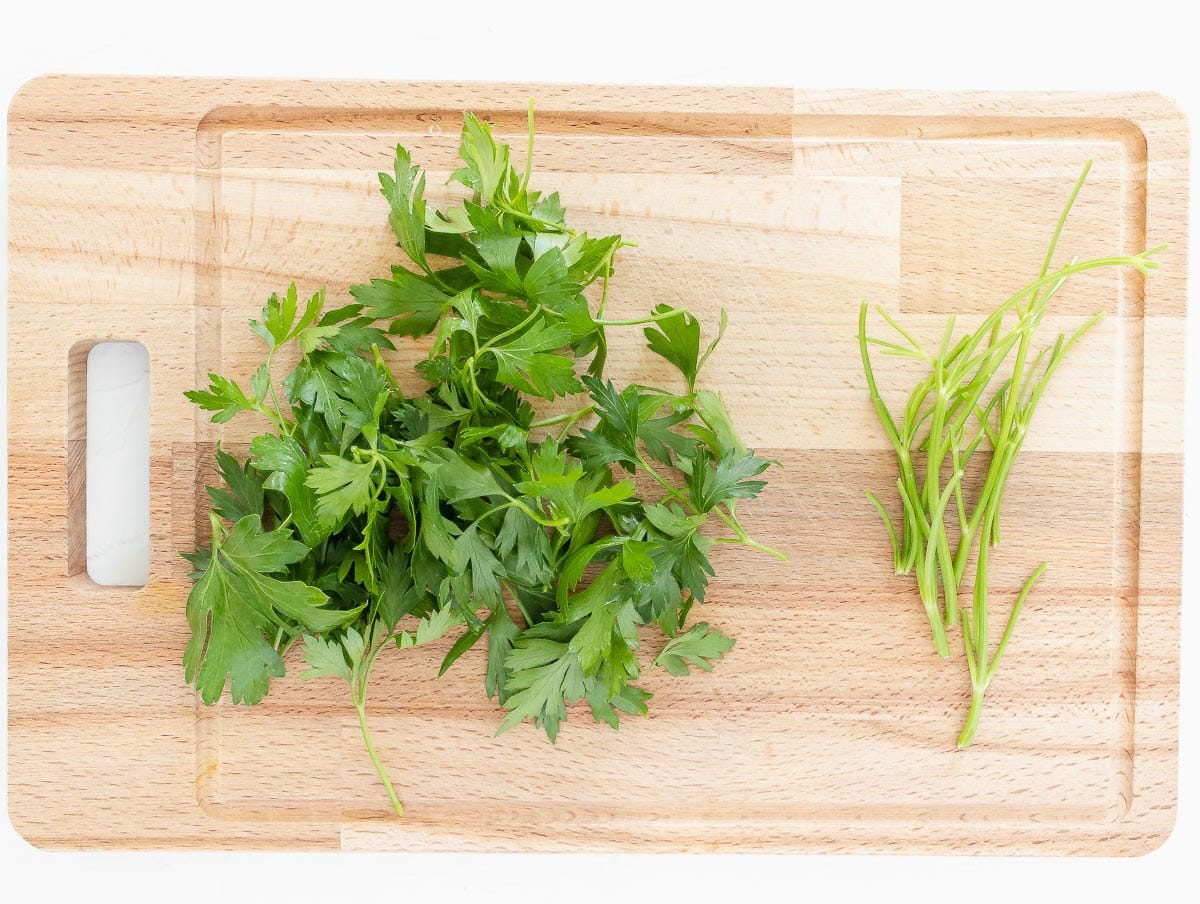
With a sharp knife, finely chop the parsley leaves. To chop the parsley, gather it tightly between your fingers and the cutting board, and cut it down with a knife as if you were slicing it.
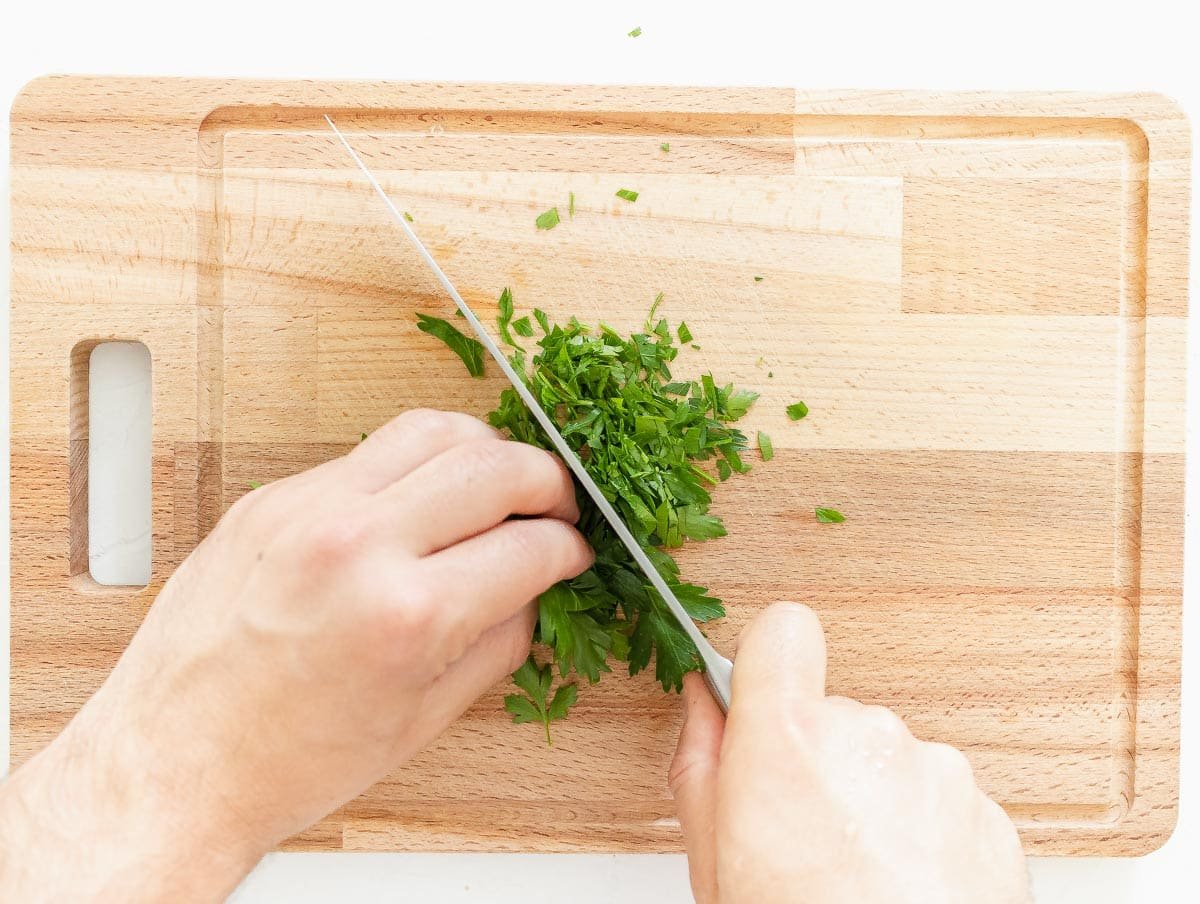
Now place the palm of your hand towards the front of the knife. Your fingers should be straight, pointing forward so that they don’t get caught under the knife.
Holding the knife firmly with your right hand, rock it up and down, chopping the parsley finely.
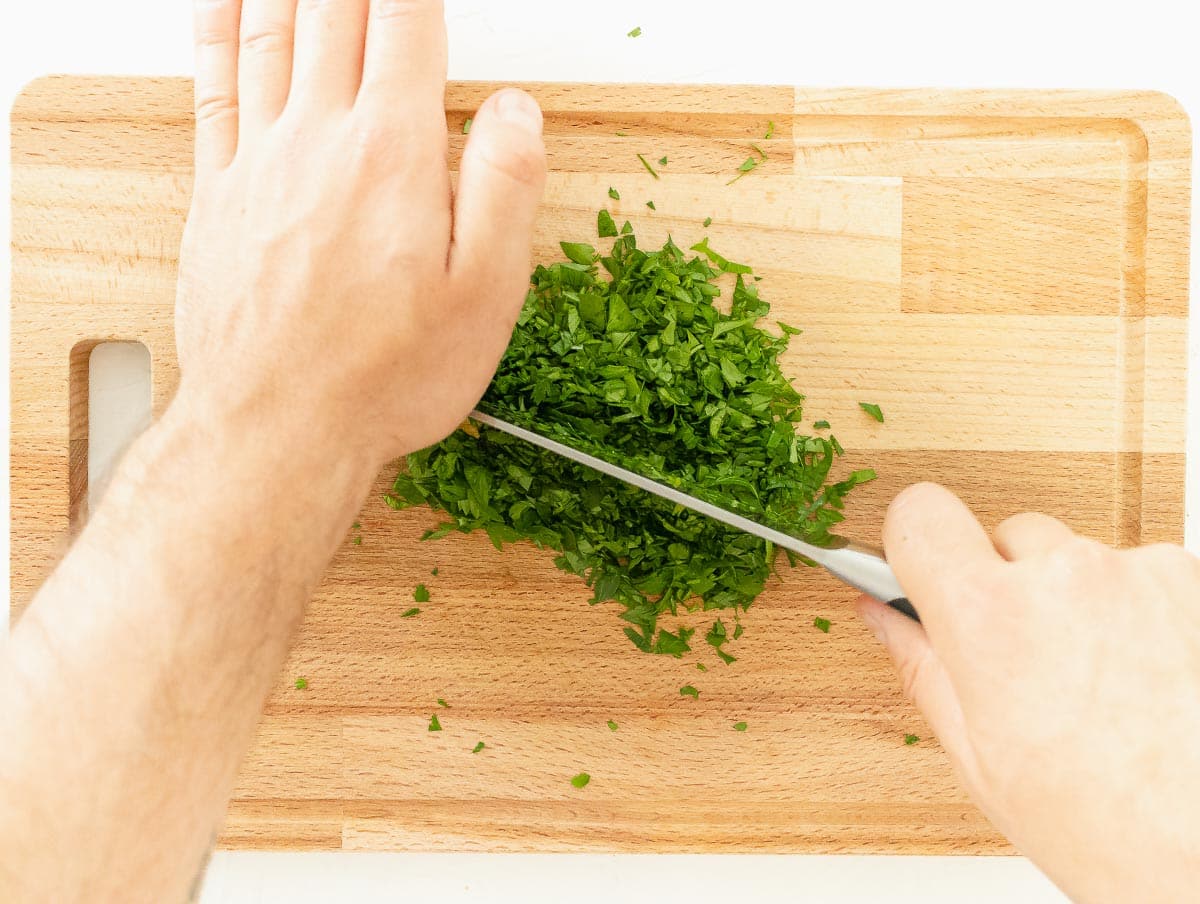
We like our parsley chopped finely for chimichurri. If you like it a little coarser that’s fine too.
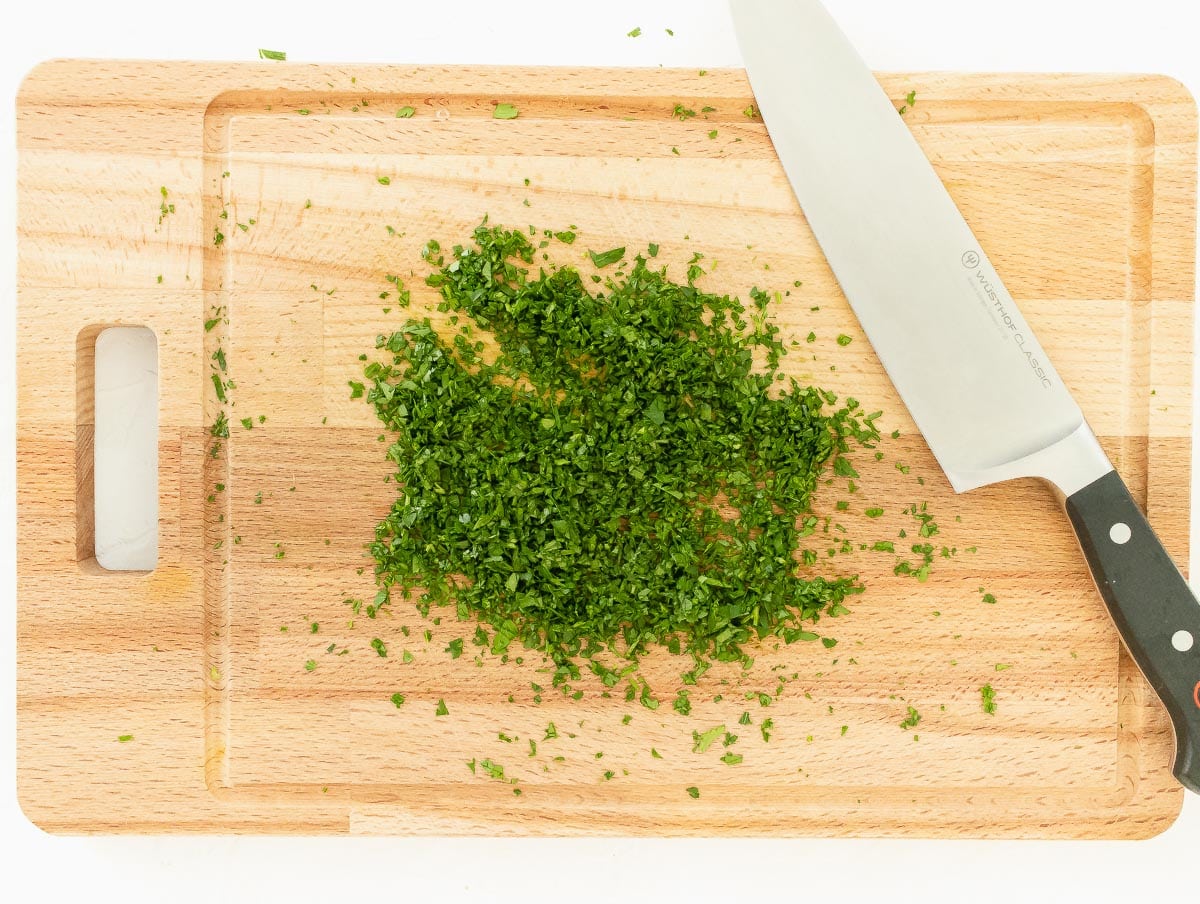
Mince the garlic
Peel and cut the garlic lengthwise. Remove the core of the garlic (if any) with the tip of a knife.
Tip: this step is optional, but we find that removing the core of the garlic makes it more digestible.
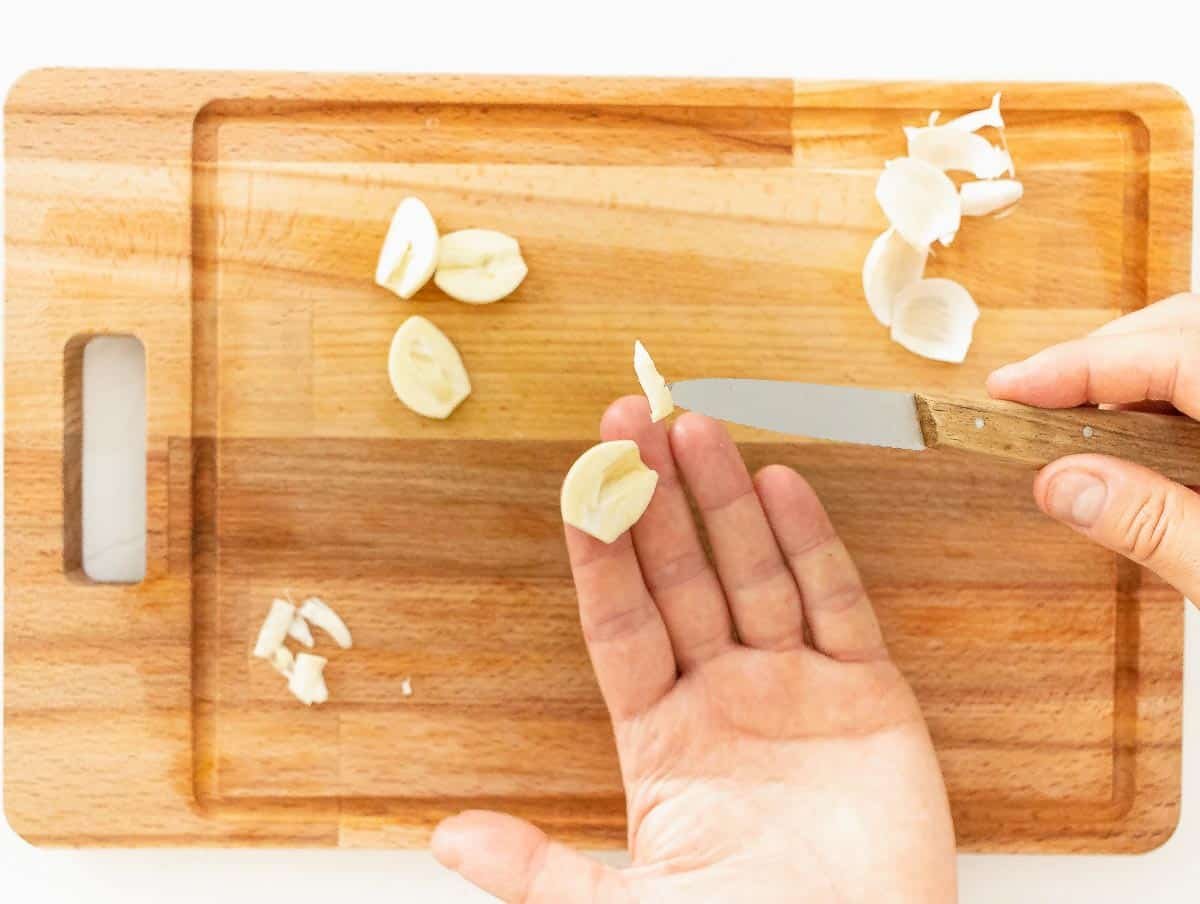
With the tip of the knife, slice the garlic clove thinly on the long side, without going all the way through.
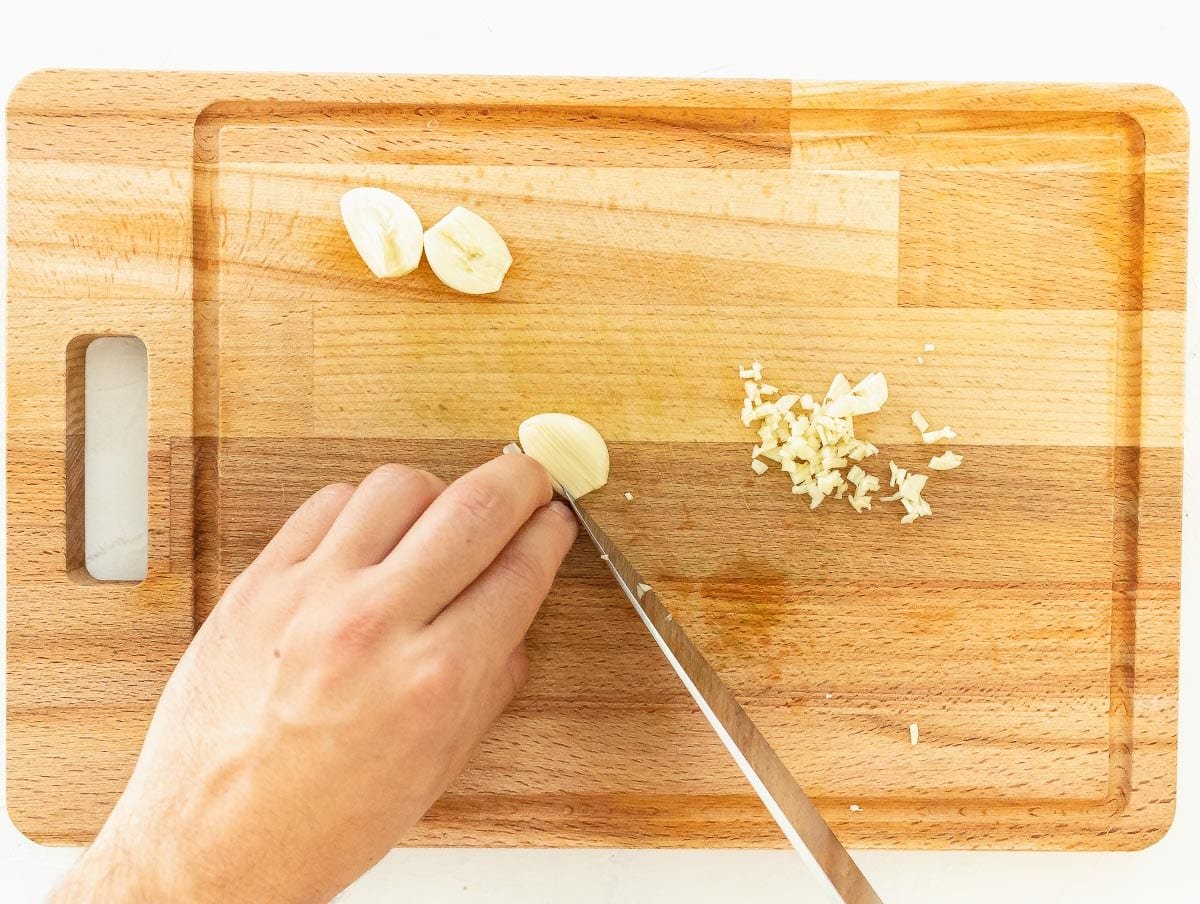
Rotate the clove by 90° and chop finely.
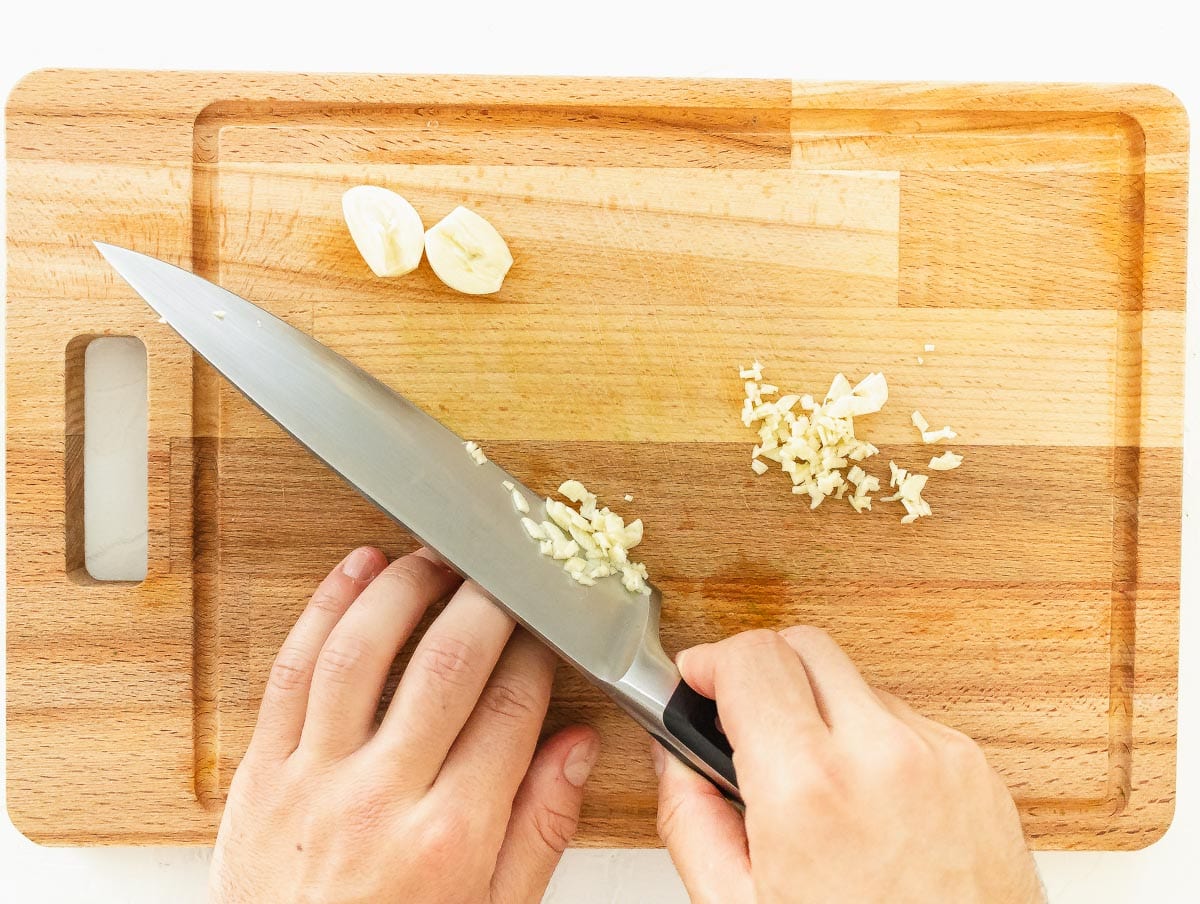
Repeat with all garlic cloves until all your garlic is minced. If you like it minced finer, then keep chopping it for a little longer.
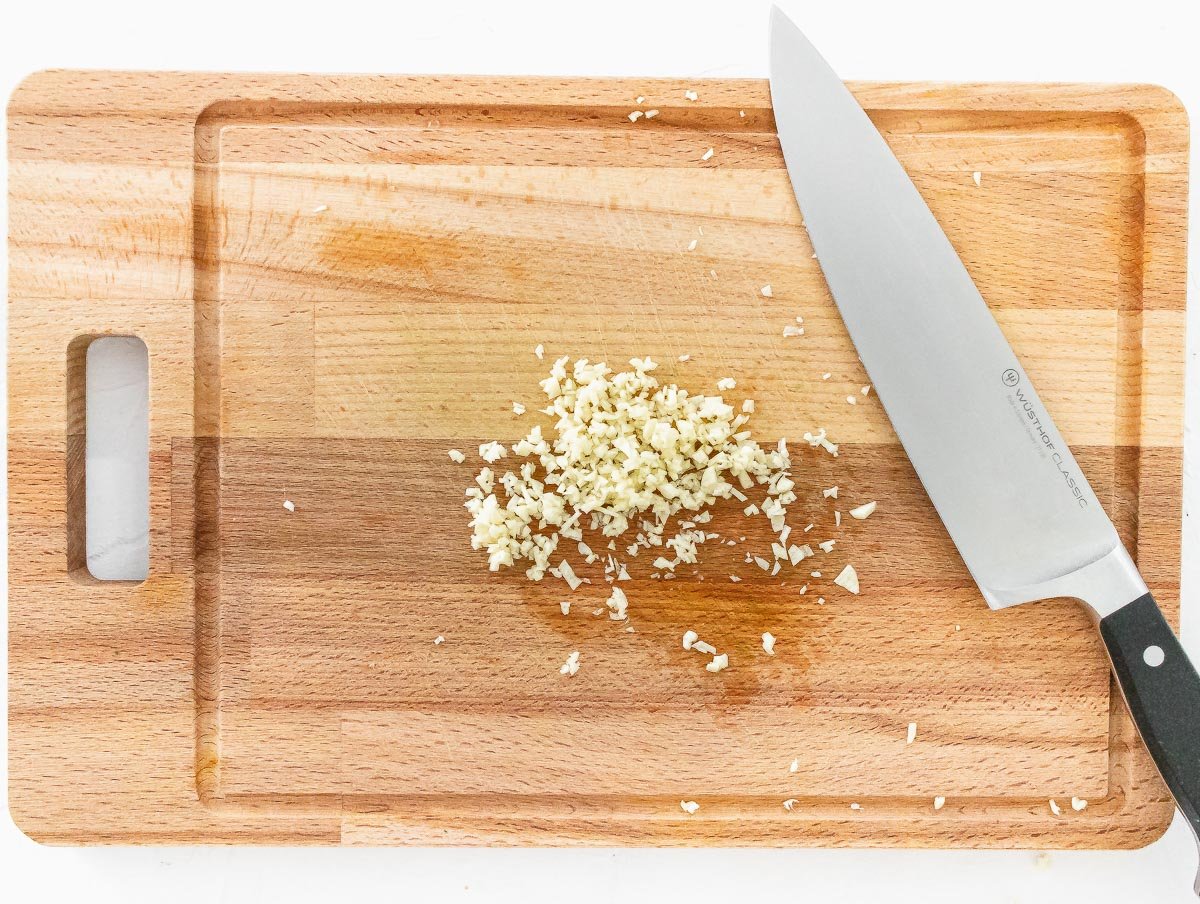
Mix ingredients together
To a small mixing bowl, or in a jar, add the finely chopped parsley, minced garlic, dry oregano, red pepper flakes, salt, olive oil, and red wine vinegar.
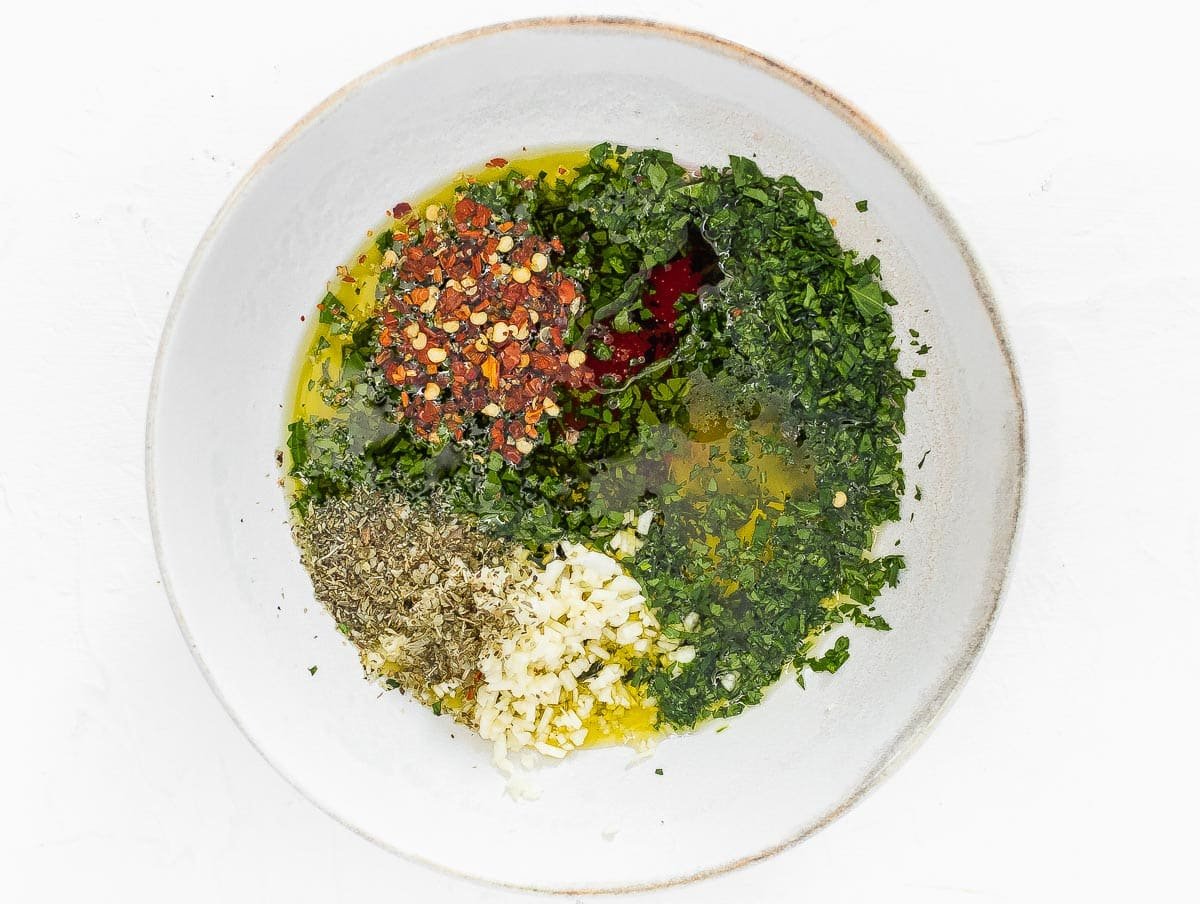
Stir well with a spoon and your chimichurri is ready.
It’s best to wait a few minutes before using chimichurri so that the flavors come together. Even better if you make it the day before serving it.
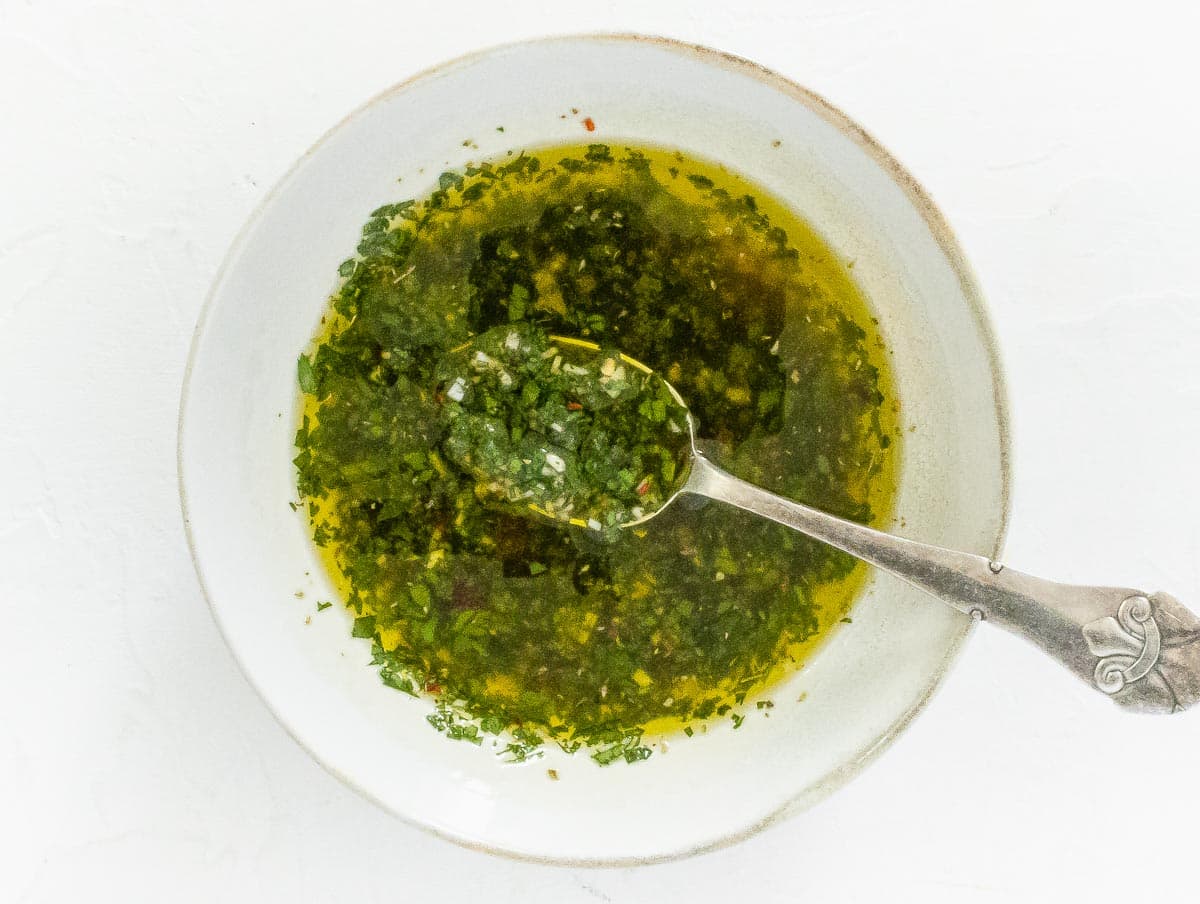
How to use chimichurri?
Drizzling: You can use chimichurri to spoon over, or drizzle over food, mainly grilled or roasted dishes, but steamed and boiled foods work too.
Basting: You can also use chimichurri for basting food as it grills. That means applying chimichurri, ideally with a brush, over the food that is grilling to keep it moist and infuse it with flavor.
Marinating: traditionally chimichurri is not used as a marinade. However, if you want to, you can use it as such.
Dipping: chimichurri is not suitable for dipping. It’s too thin and slippery and won’t stick to the food that you dip in it.
Serving suggestions
Grilled foods: chimichurri and grilled foods are like peanut butter and jam. They belong together! Traditionally chimichurri is served on grilled meat and fish such as steak, chicken, salmon, and shrimp. Some serve it on boiled eggs.
We love to spoon it over grilled tofu, zucchini, asparagus, and eggplant. The bright, acidic, herby, and mildly spicy flavor brings those dishes to life.
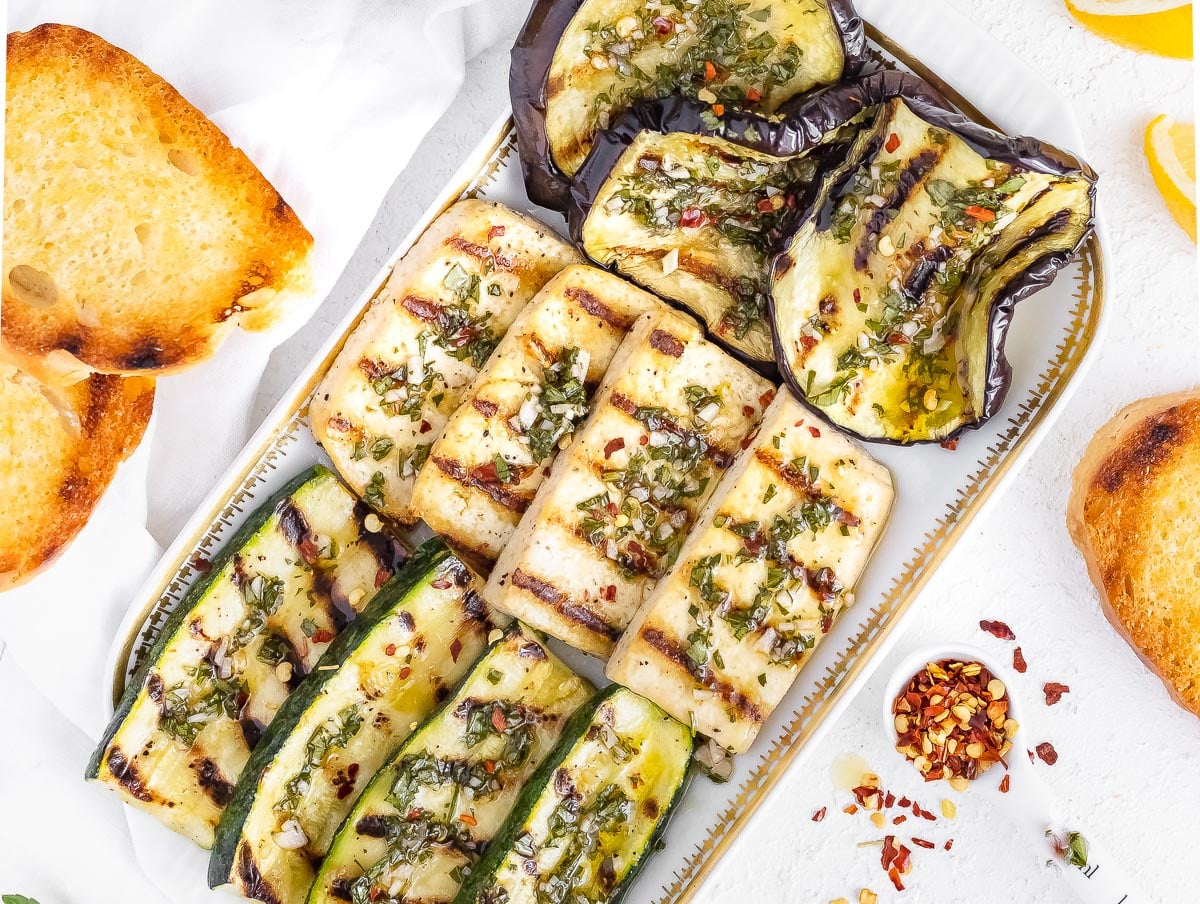
Oven-roasted foods: if you are not into grilling, try chimichurri on over-roasted foods. We made these delicious slow-roasted carrots with olive oil, salt, pepper, and a pinch of sugar towards the end to caramelize them. We drizzled them with chimichurri and our world changed. Thanks to this magic condiment, carrots, artichokes, and brussels sprouts have become new obsessions in our home.
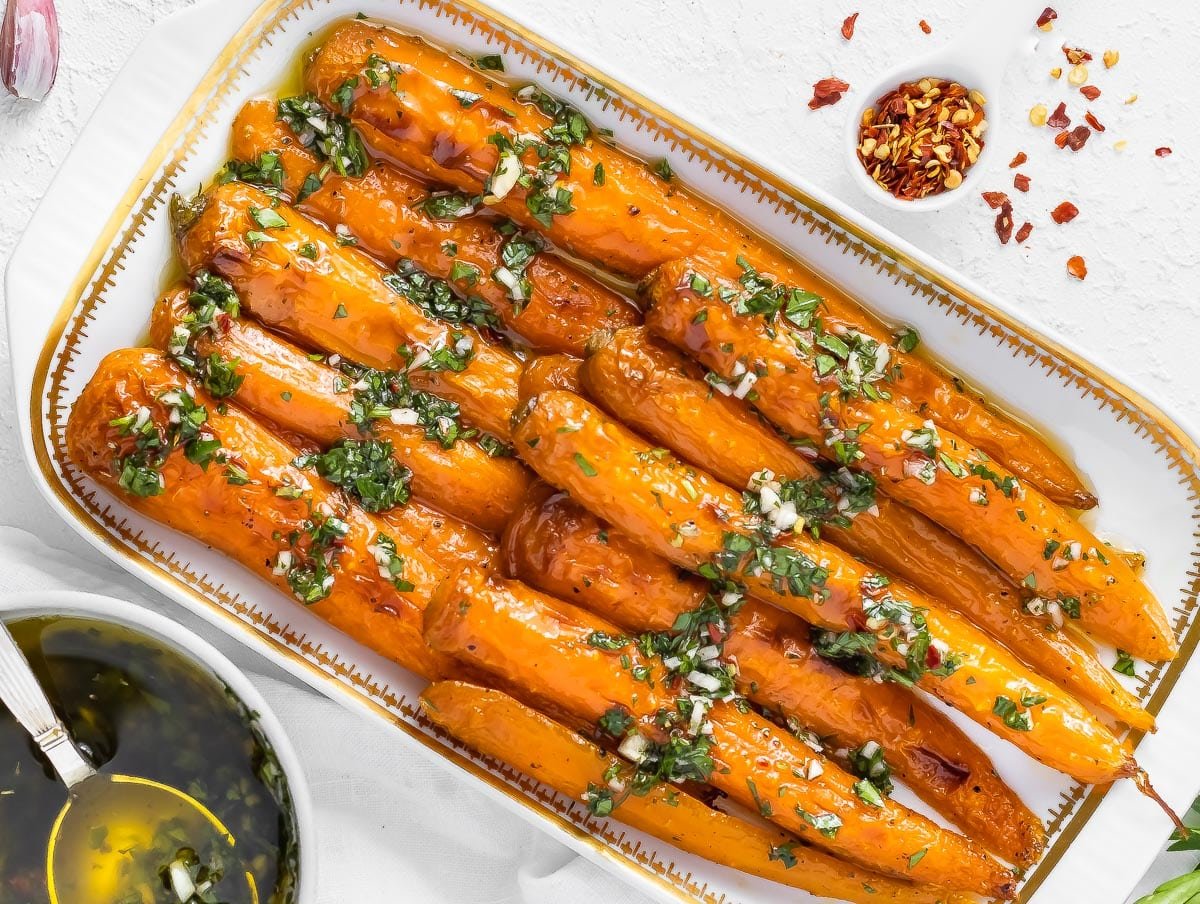
Boiled and steamed foods: because of its intense taste and aroma chimichurri is perfect to add a burst of flavor to boiled or steamed food, such as boiled potatoes, carrots, asparagus, artichokes, and tofu fish.
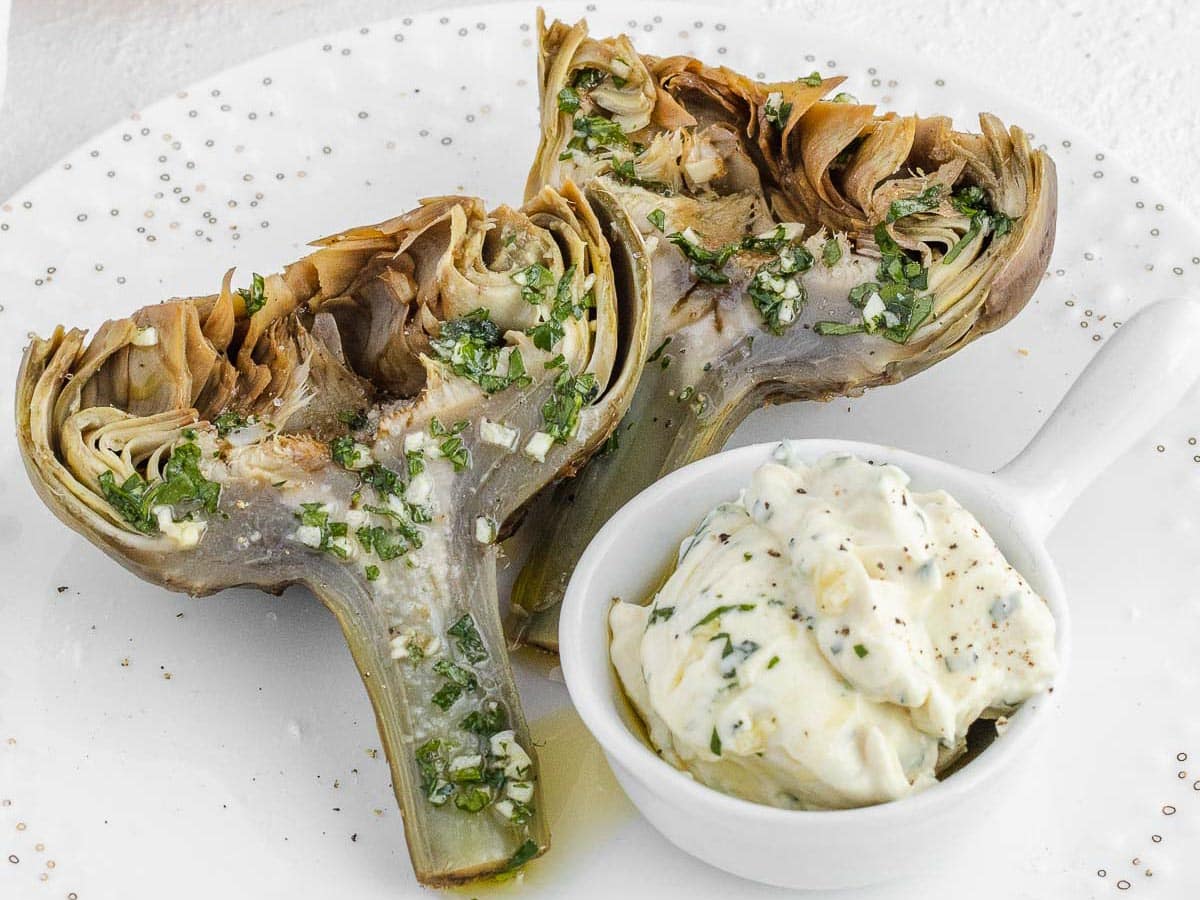
Legumes: you can even use it as a dressing for beans and chickpeas. Try boiling canned cannellini beans for 5 minutes, drain them, and toss them in chimichurri. Serve on top of mashed roasted or boiled carrots or potatoes. It’s delicious!
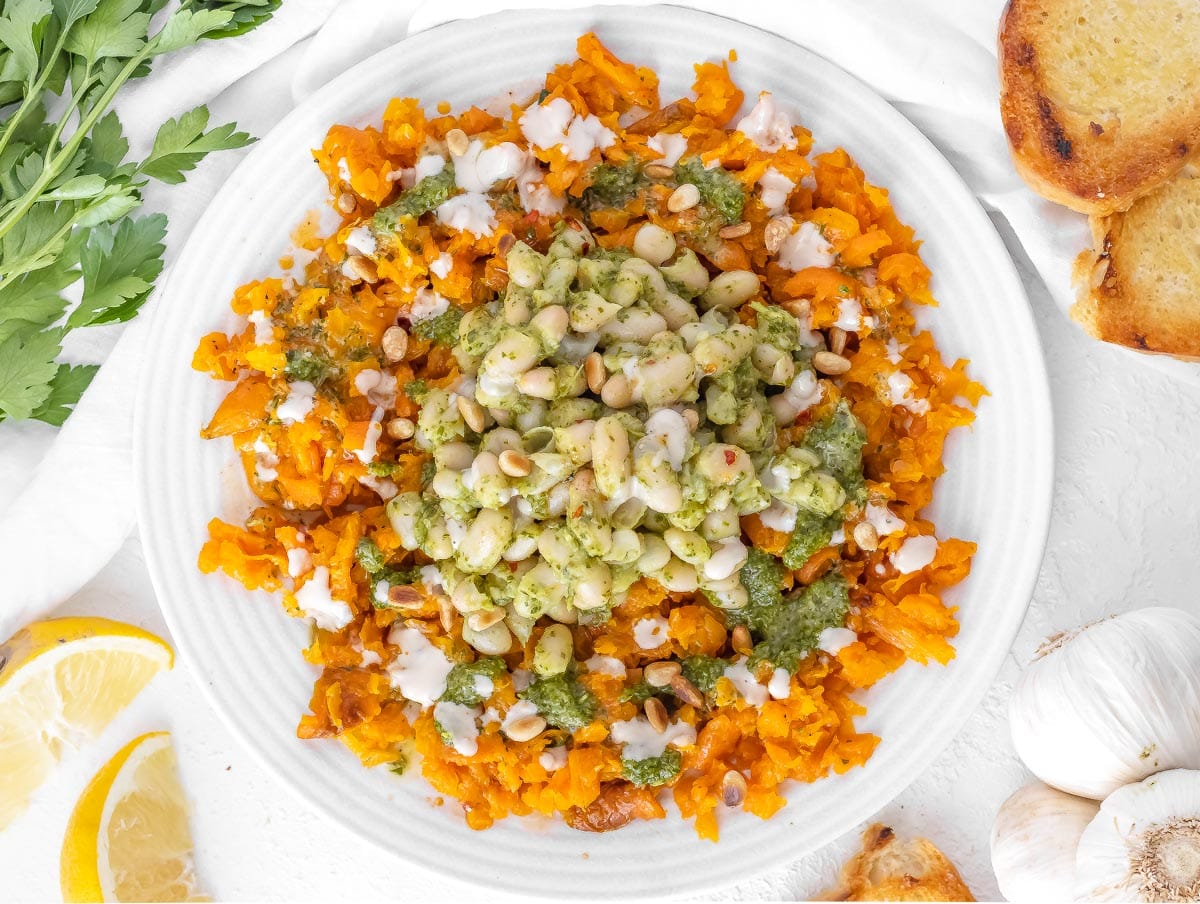
More vegan sauces
If you’re looking to add pop and bold flavor to your veggies and salad recipes, check out this selection of sauces:
- Mustard dressing: a versatile alternative to honey mustard dressing, light, sweet and tangy.
- Tahini sauce: a middle-eastern favorite with tahini and fresh lemon – a creamy addition to tofu salad and much more.
- Cilantro lime dressing: a great side dish for taco Tuesday and a good pairing with Tex-Mex bowls.
- Chipotle sauce: drizzle on your favorite salad, or flatbread pizza, or add to tacos and taco bowls.
- Vegan mayo: an easy 5-minute recipe that is now one of our favorite dips for potatoes and veggie fries.
- Quick chili oil: a refreshing way to infuse your bowl of salad or plant-based protein with heat.
- Green goddess dressing: adds creaminess and nutrition to anything, from couscous salad to potato salad.
- Vegan pesto with basil: A staple in our fridge, packed with healthy fats and umami, pesto pairs perfectly with pasta and pasta salad.
Which dressing is your favorite to serve with salads? We’d love to hear from you, let us know in the comments below!
Questions
No. They are two completely different recipes. We have a whole blog post on how to make the best vegan pesto here. Traditional Italian pesto is made with basil, pine nuts, and parmesan, there’s no vinegar, and is generally served with pasta.
The one thing that chimichurri and pesto have in common is that both of them are traditionally made with pestle and mortar.
Yes, you can use a food processor or a blender. If you do so add all ingredients to the food processor and pulse until you reach your desired consistency (do not blend continuously or you’ll risk over blending it).
Technically chimichurri is very similar to a herby vinaigrette or Italian seasoning and so you could in theory use it to dress salads.
However, chimichurri has a stronger, spicier, and more pungent flavor than a regular vinaigrette because it was developed to go with grilled foods.
My advice would be to reduce the garlic and red pepper flakes amount if you want to use it as a salad dressing.
Storage
Store chimichurri in the refrigerator for up to 5 days. As the days go by, the parsley will change color and turn darker. That’s normal.
You can freeze chimichurri like you would pesto. Pour it with a spoon into ice cube trays, trying to evenly spread the parsley. Freeze for a few hours, then pop out of the ice cube trays and transfer into a freezing bag. Put back into the freezer and use as you need.
Thaw in the fridge overnight. Do now microwave or refreeze multiple times.
For more condiment ideas, check out our dressing and sauces category page.
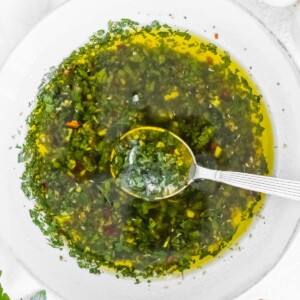
Chimichurri Recipe
Ingredients
- ½ packed cup parsley finely chopped
- 2 cloves garlic minced
- ¼ teaspoon red pepper flakes
- ¼ teaspoon dried oregano
- ½ teaspoon salt
- ⅓ cup extra virgin olive oil
- 2 tablespoons red wine vinegar
Instructions
- Wash and pat dry the parsley. Remove the thicker stems, and finely chop it.
- Peel the garlic and cut it in half lengthwise. Remove the core (if any) then finely mince the garlic.
- To a small mixing bowl or in a medium sized jar, add finely chopped parsley, minced garlic, dried oregano, salt, red pepper flakes, olive oil, and vinegar.
- Mix well with a spoon and your chimichurri is ready. For best flavor, let sit for at least 10 minutes before serving.
Video
Notes
Nutrition
You might also like:

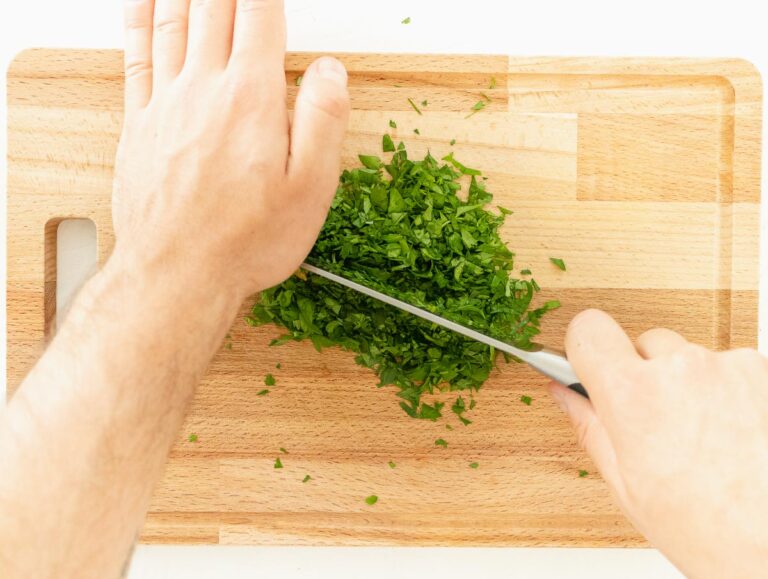
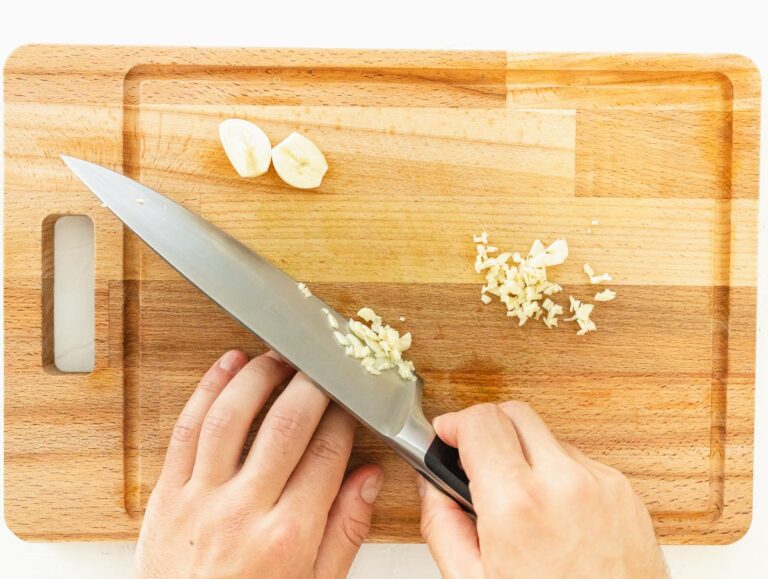
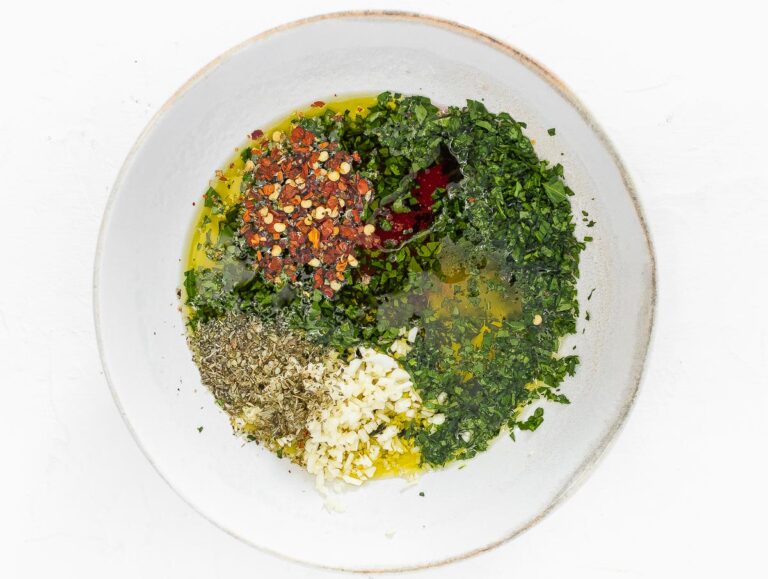
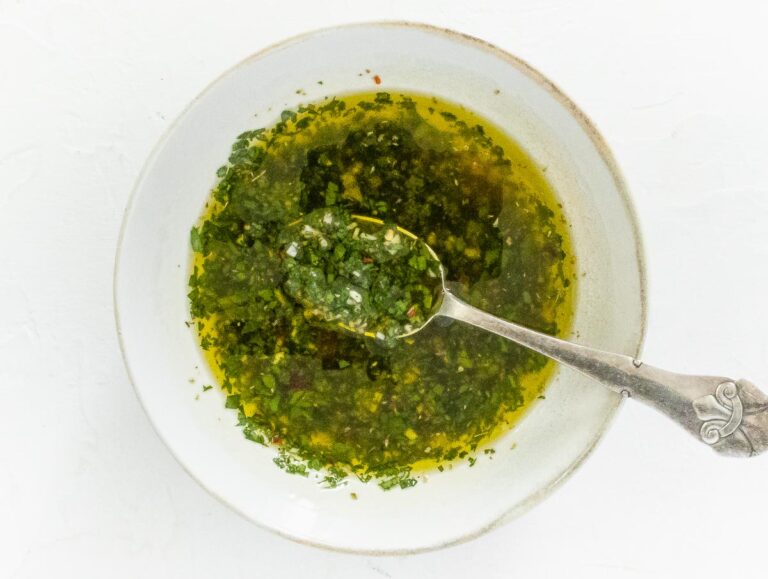


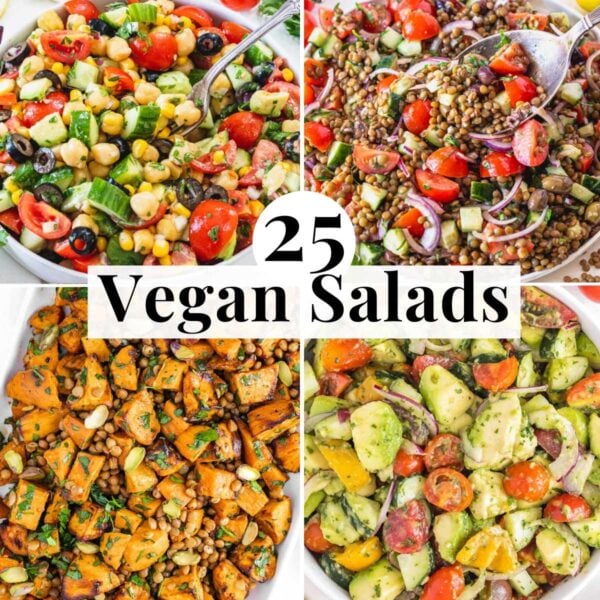

Delicious and easy to make! Poured it over grilled steaks and potatoes, no need for steak sauces with all the preservatives. Do wait at least 10 mins before using as recipe indicates.